The son of a commercial potter in Sebring, Ohio, Viktor Schreckengost learned the craft of sculpting in clay from his father. In the mid-1920s, he enrolled at the Cleveland School of Art (now the Cleveland Institute of Art, or CIA) to study cartoon making, but after seeing an exhibition at the Cleveland Museum of Art, he changed his focus to ceramics. Upon graduation in 1929, he studied ceramics in Vienna, Austria, where he began to build a reputation, not only for his art, but also as a jazz saxophonist.
A year later, at the age of 25, he became the youngest faculty member at the CIA. In 1931, Schreckengost won the first of several awards for excellence in ceramics at the Cleveland Museum of Art, and his works were exhibited at the Metropolitan Museum of Art, the Art Institute of Chicago, the Panama-Pacific Exposition in San Francisco, and elsewhere.
By the mid-1930s, Viktor had started to pursue his interest in industrial design. For American Limoges, he created the first modern mass-produced dinnerware called Americana. Along with engineer Ray Spiller, Schreckengost designed the first-cab-over-engine truck for Cleveland’s White Motor Company.
By the end of the decade, Viktor became the chief bicycle designer for Murray-Ohio, a position held formerly by the famous Count Alexis de Sakhnoffsky. In 1939, he released his first design, the Mercury Bicycle, which was displayed along with four of his sculptures (The Four Elements) at the New York World’s Fair. In the early 1940s, Viktor began quietly revolutionizing the manufacture of children’s pedal cars as well.
World War II interrupted his design and ceramic work when he joined the US Navy. His talents were soon recognized, and he was recruited to develop a system for radar recognition that won him the Secretary of Navy’s commendation.
After the war, Schreckengost resumed his industrial design career creating products for Murray, Sears, General Electric, Salem China Company, and Harris Printing, among others. Approximately 100 million of his bicycles and pedal cars were manufactured by Murray, which made it the largest bicycle-maker in the world.
He retired from industrial design in 1972, but continued teaching at the Cleveland Institute of Art. Today, he is Professor Emeritus at the institute and continues to follow the progress of his former students and help where he can on campus.

